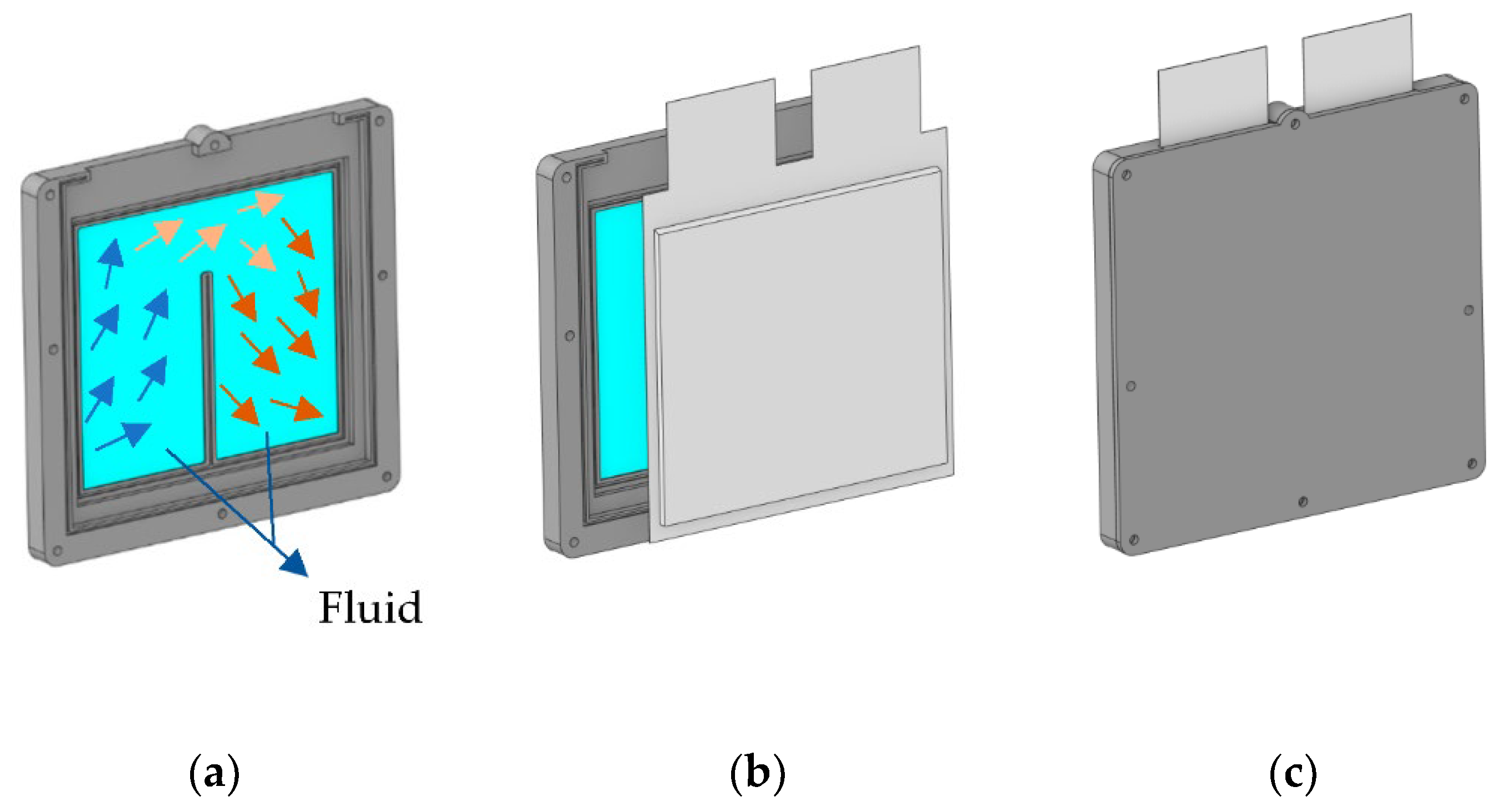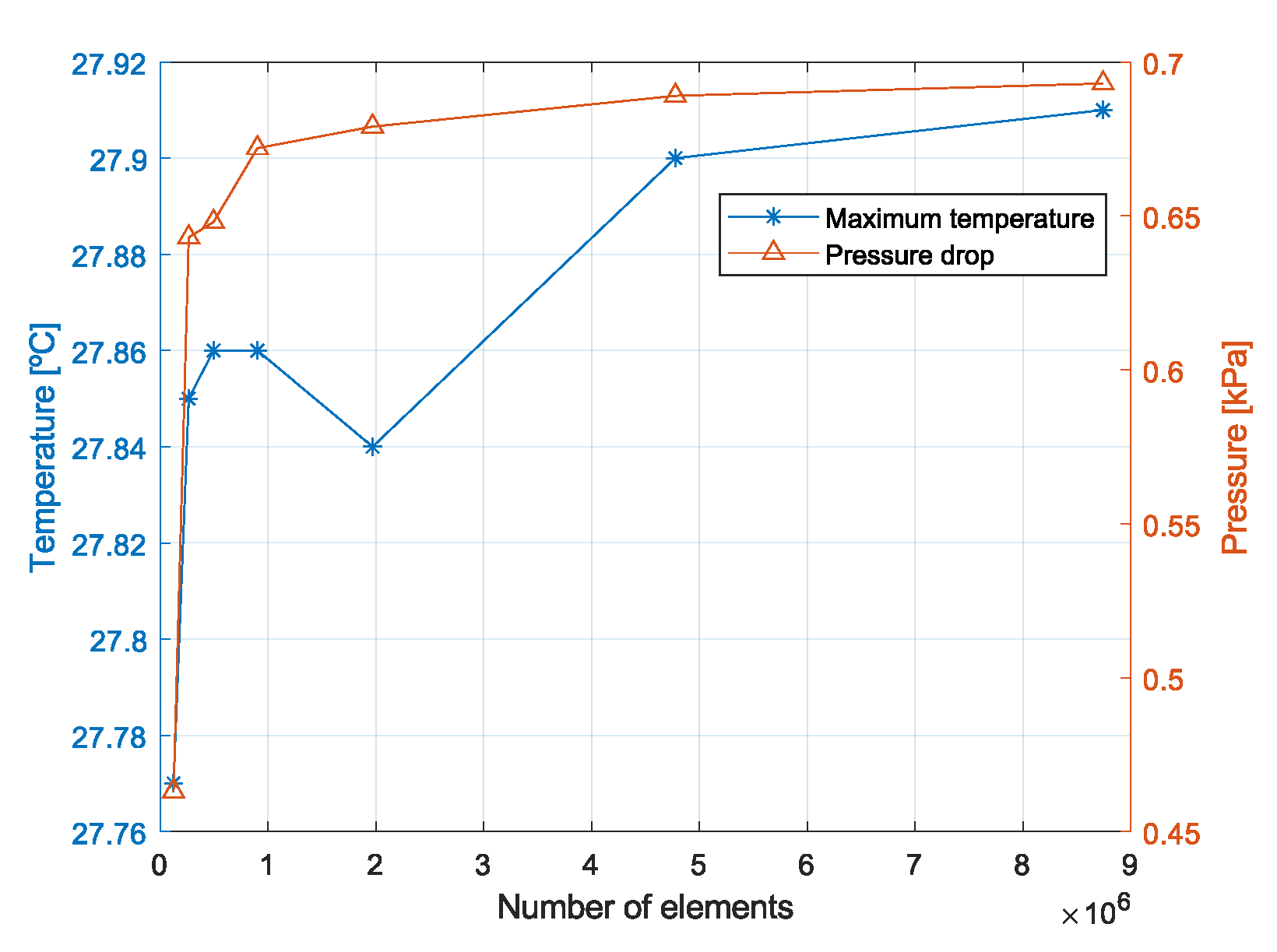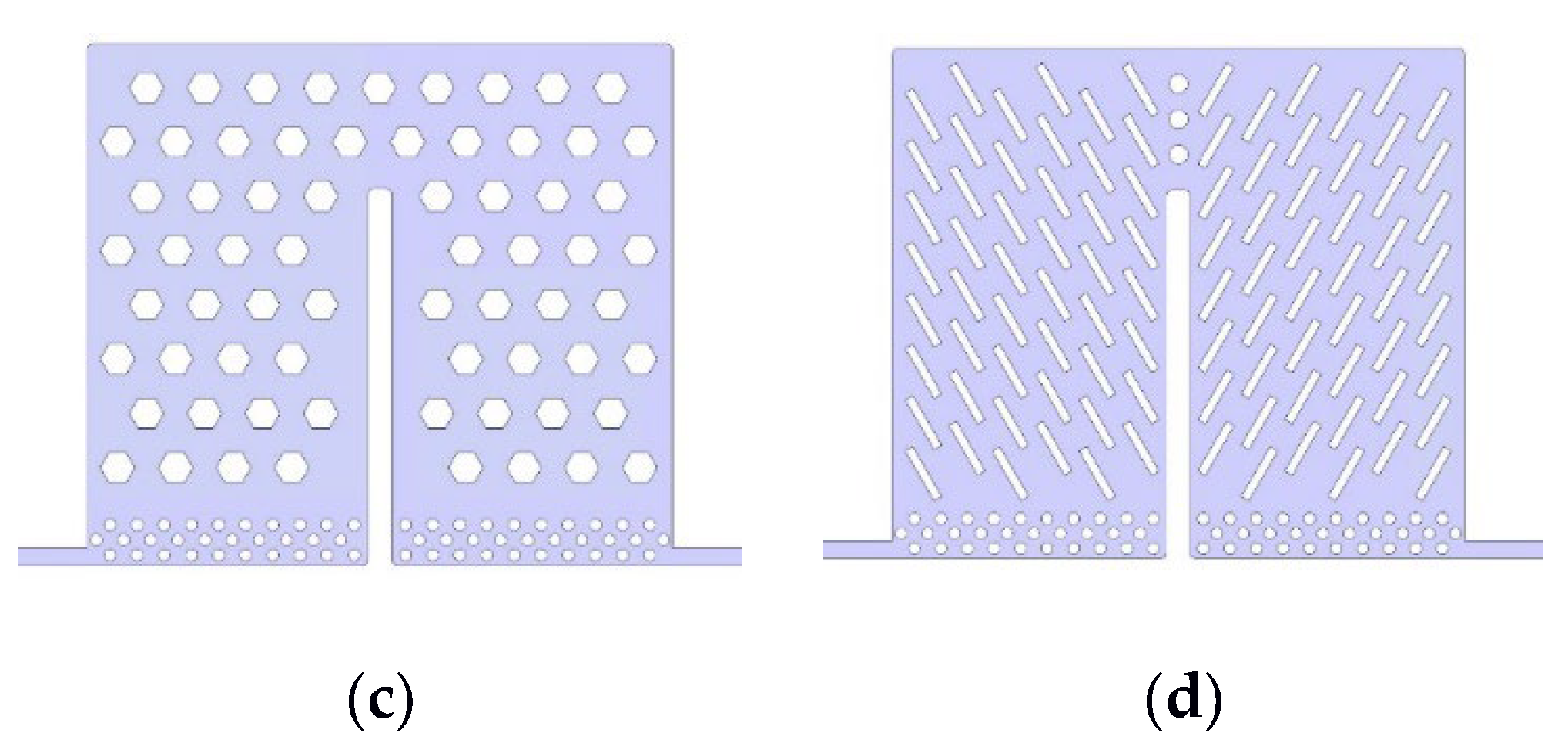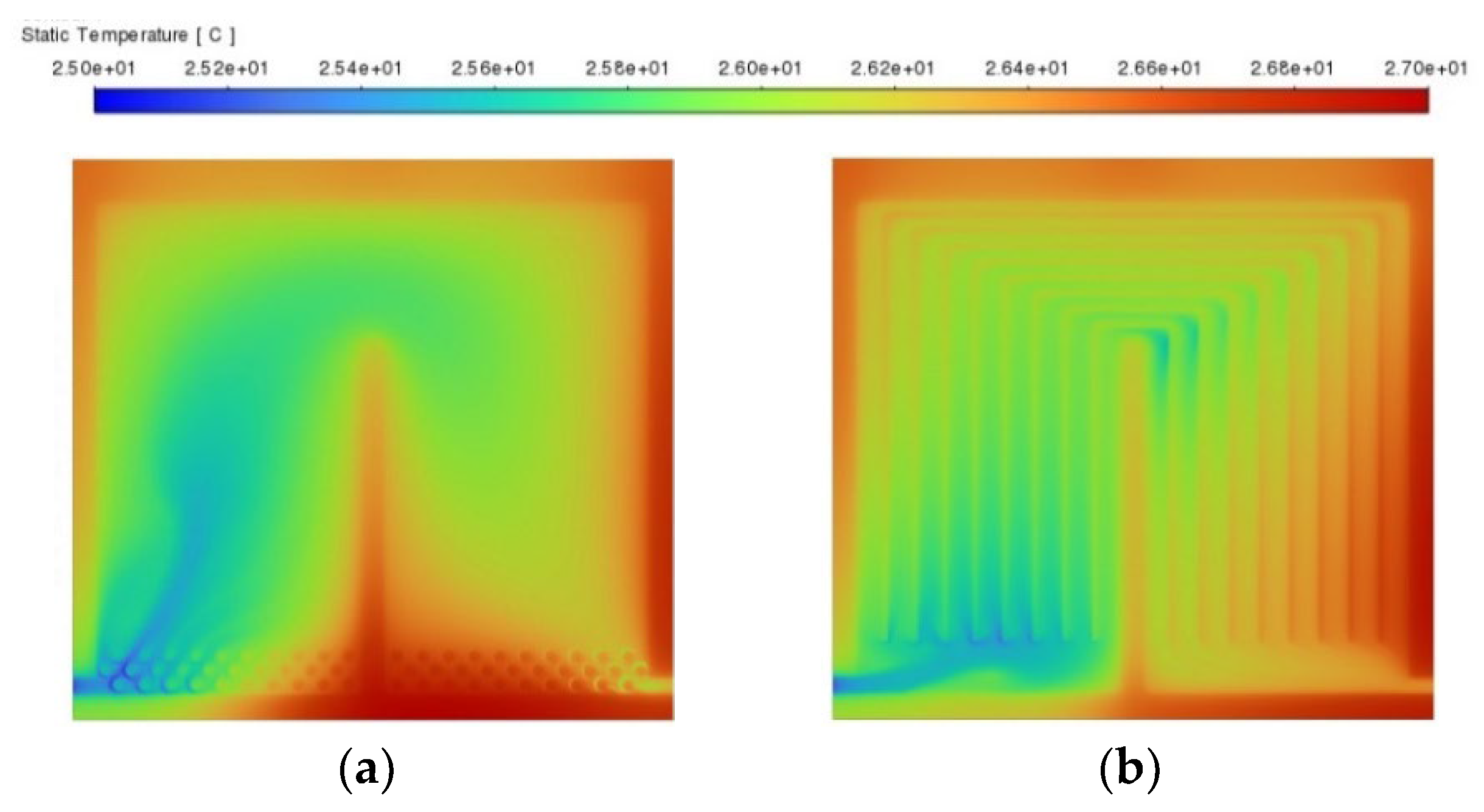Parametric Optimisation of a Direct Liquid Cooling–Based Prototype for Electric Vehicles Focused on Pouch-Type Battery Cells
Abstract
:1. Introduction
2. Numerical Model Description
2.1. Physical Model
2.2. Simulation Model Geometry
2.3. Battery Modelling
2.4. Mesh Independence
3. Flow Pattern Design Selection
3.1. Boundary Conditions
3.2. Results and Discussion

4. Design Optimisation
4.1. Parametrisation of the Geometry
4.2. Output Variables
4.3. Optimisation Process Definition
4.4. Results and Analysis
5. Conclusions
- At flow rates below 0.4 L/min, the flow distribution channels defined on the U-shape design improve the fluid dynamical aspect of the cooling strategy, maintaining the highest thermal performance of the battery cell without increasing the power consumption. It was therefore selected to develop the parametric optimisation process.
- Developed surrogate models presented that the most critical parameters that influence the output variable results were the height of the fluid channel (Hf) and the flowrate definition (Q), which are directly related to the fluid local velocity.
- The number of channels (Nc) increases the power consumption of the system (Ph) while decreasing the thermal heterogeneity of the battery cell (ΔT). Therefore, it is recommended to decrease the number of channels remaining the thermal distribution of the cell within the optimal range.
- The number of distributors (Nd) increases the power consumption of the system (Ph) and the thermal heterogeneity of the battery cell (ΔT). However, a minimum number of components to adequately distribute the inflow and outflow are necessary, thus avoiding hot spots in the system.
- The proposed parametric optimisation defined the optimum design of the DLC strategy that ensures the optimal relationship among Tmax, ΔT, VED, and Ph. The corresponding values of the design parameters were Hf = 1 mm, Nc = 9, Nd = 10, and Q = 0.13 L/min. This design case maintains Tmax at 27.72 and ΔT at 0.65 with the maximum VED value and reducing Ph by 90%.
Author Contributions
Funding
Institutional Review Board Statement
Informed Consent Statement
Data Availability Statement
Conflicts of Interest
Abbreviations
| ANOVA | analysis of variance |
| CFD | computational fluid dynamics |
| DLC | direct liquid cooling |
| DoE | design of experiments |
| ECM | equivalent circuit model |
| EV | electric vehicle |
| HEV | hybrid electric vehicle |
| HP | heat pipes |
| HPPC | hybrid pulse power characterization |
| ILC | indirect liquid cooling |
| LC | liquid cooling |
| NMC | nickel manganese cobalt |
| OCV | open circuit voltage |
| PCM | phase change material |
| SOC | state of charge |
| TEC | thermoelectric material |
| UDF | user-defined functions |
| VED | volumetric energy density |
References
- International Energy Agency. Global EV Outlook 2020. Glob. EV Outlook 2020, 191, 116565. [Google Scholar]
- Choudhari, V.; Dhoble, A.; Sathe, T. A review on effect of heat generation and various thermal management systems for lithium ion battery used for electric vehicle. J. Energy Storage 2020, 32, 101729. [Google Scholar] [CrossRef]
- Han, X.; Lu, L.; Zheng, Y.; Feng, X.; Li, Z.; Li, J.; Ouyang, M. A review on the key issues of the lithium ion battery degradation among the whole life cycle. eTransportation 2019, 1, 100005. [Google Scholar] [CrossRef]
- Patil, M.S.; Seo, J.-H.; Panchal, S.; Jee, S.-W.; Lee, M.-Y. Investigation on thermal performance of water-cooled Li-ion pouch cell and pack at high discharge rate with U-turn type microchannel cold plate. Int. J. Heat Mass Transf. 2020, 155, 119728. [Google Scholar] [CrossRef]
- Kim, J.; Oh, J.; Lee, H. Review on battery thermal management system for electric vehicles. J. Appl. Therm. Eng. 2019, 149, 192–212. [Google Scholar] [CrossRef]
- Rouaud, C. Automotive Thermal Management, Online Conference. 19.11.2020. Available online: https://lp.bcf-events.com/automotive-thermal-management-online-conference-2020/ (accessed on 19 November 2020).
- Chung, Y.; Kim, M.S. Thermal analysis and pack level design of battery thermal management system with liquid cooling for electric vehicles. Energy Convers. Manag. 2019, 196, 105–116. [Google Scholar] [CrossRef]
- Yang, C.; Cao, L. The Role of Interfacial Thermal Resistance in Li-Ion Battery Thermal Management. In Proceedings of the ASME 2019 International Technical Conference and Exhibition on Packaging and Integration of Electronic and Photonic Microsystems, Anaheim, CA, USA, 7–9 October 2019. [Google Scholar] [CrossRef]
- 3M. 3M Novec 7000 Engineered Fluid Product Information. 2005, pp. 1–6. Available online: http://multimedia.3m.com/mws/mediawebserver?66666UuZjcFSLXTtlXftMxMVEVuQEcuZgVs6EVs6E666666-- (accessed on 16 April 2020).
- XING Mobility Dynamic Power on Demand. 2022. Available online: https://www.xingmobility.com/assets/pdf/XingMobility_DynamicPower_OnDemand.pdf (accessed on 3 April 2020).
- Battery, K. Kreisel Battery Pack. 2022. Available online: https://www.kreiselelectric.com/ (accessed on 10 March 2020).
- Park, S.; Jung, D. Battery cell arrangement and heat transfer fluid effects on the parasitic power consumption and the cell temperature distribution in a hybrid electric vehicle. J. Power Sources 2013, 227, 191–198. [Google Scholar] [CrossRef]
- Sundin, D.W.; Sponholtz, S. Thermal Management of Li-Ion Batteries with Single-Phase Liquid Immersion Cooling. IEEE Open J. Veh. Technol. 2020, 1, 82–92. [Google Scholar] [CrossRef]
- Dubey, P.; Pulugundla, G.; Srouji, A. Direct Comparison of Immersion and Cold-Plate Based Cooling for Automotive Li-Ion Battery Modules. Energies 2021, 14, 1259. [Google Scholar] [CrossRef]
- Tan, X.; Lyu, P.; Fan, Y.; Rao, J.; Ouyang, K. Numerical investigation of the direct liquid cooling of a fast-charging lithium-ion battery pack in hydrofluoroether. Appl. Therm. Eng. 2021, 196, 117279. [Google Scholar] [CrossRef]
- Patil, M.S.; Seo, J.-H.; Lee, M.-Y. A novel dielectric fluid immersion cooling technology for Li-ion battery thermal management. Energy Convers. Manag. 2020, 229, 113715. [Google Scholar] [CrossRef]
- Le, Q.; Shi, Q.; Liu, Q.; Yao, X.; Ju, X.; Xu, C. Numerical investigation on manifold immersion cooling scheme for lithium ion battery thermal management application. Int. J. Heat Mass Transf. 2022, 190, 122750. [Google Scholar] [CrossRef]
- Battery University. Battery University—BU-301a: Types of Battery Cells. 2021. Available online: https://batteryuniversity.com/article/bu-301a-types-of-battery-cells (accessed on 25 February 2020).
- Tran, M.-K.; Mevawala, A.; Panchal, S.; Raahemifar, K.; Fowler, M.; Fraser, R. Effect of integrating the hysteresis component to the equivalent circuit model of Lithium-ion battery for dynamic and non-dynamic applications. J. Energy Storage 2020, 32, 101785. [Google Scholar] [CrossRef]
- Li, Y.; Chen, M.; Bai, F.; Song, W.; Feng, Z. Thermal equilibrium characteristic of large-size lithium-ion pouch battery: Resting time between charge and discharge. Energy Procedia 2019, 158, 2623–2630. [Google Scholar] [CrossRef]
- Wu, X.; Lv, S.; Chen, J. Determination of the Optimum Heat Transfer Coefficient and Temperature Rise Analysis for a Lithium-Ion Battery under the Conditions of Harbin City Bus Driving Cycles. Energies 2017, 10, 1723. [Google Scholar] [CrossRef] [Green Version]
- Larrañaga, M. Design and implementation of a Direct Liquid Cooling strategy for HEV/EV focus on a pouch type cell body refrigeration. In Proceedings of the Thermal Management Systems Symposium (21TMSS), Online, 12–14 October 2021. [Google Scholar]
- Li, M.; Wang, J.; Guo, Q.; Li, Y.; Xue, Q.; Qin, G. Numerical Analysis of Cooling Plates with Different Structures for Electric Vehicle Battery Thermal Management Systems. J. Energy Eng. 2020, 146, 04020037. [Google Scholar] [CrossRef]
- Panchal, S.; Khasow, R.; Dincer, I.; Agelin-Chaab, M.; Fraser, R.; Fowler, M. Numerical modeling and experimental investigation of a prismatic battery subjected to water cooling. Numer. Heat Transfer Part A Appl. 2017, 71, 626–637. [Google Scholar] [CrossRef]
- Brown, G.O. The History of the Darcy-Weisbach Equation for Pipe Flow Resistance. Proc. Environ. Water Resour. Hist. 2002, 40650, 34–43. [Google Scholar] [CrossRef] [Green Version]












| Property | Battery Cell | Clamps | Dielectric Fluid |
|---|---|---|---|
| Material | Battery cell | Aluminium | Mineral oil |
| Kinematic Viscosity (mm2/s) | - | - | 4.3 |
| Heat Capacity (J/kgK) | 1306 | 871 | 2130 |
| Thermal conductivity (W/mK) | x,y: 17.9/z: 0.65 | 202.4 | 0.135 |
| Density (kg/m3) | 2183 | 2719 | 774 |
| Resistivity (MΩm) | - | - | >5 × 106 |
| N° Simulations | Hf (mm) | Nc | Nd | Q (L/min) | Cell Level | Module Level | ||
|---|---|---|---|---|---|---|---|---|
| Tmax (°C) | ΔT (°C) | VED (Wh/L) | Ph (W) | |||||
| 1 | 3 | 9 | 30 | 0.40 | 27.52 | 0.51 | 248.70 | 0.109 |
| 2 | 1 | 9 | 30 | 0.40 | 27.00 | 0.37 | 279.78 | 1.455 |
| 3 | 3 | 3 | 30 | 0.40 | 27.51 | 0.56 | 248.70 | 0.095 |
| 4 | 1 | 3 | 30 | 0.40 | 26.98 | 0.38 | 279.78 | 1.301 |
| 5 | 3 | 9 | 10 | 0.40 | 27.56 | 0.47 | 248.70 | 0.076 |
| 6 | 1 | 9 | 10 | 0.40 | 27.02 | 0.35 | 279.78 | 1.162 |
| 7 | 3 | 3 | 10 | 0.40 | 27.51 | 0.49 | 248.70 | 0.069 |
| 8 | 1 | 3 | 10 | 0.40 | 26.98 | 0.36 | 279.78 | 1.060 |
| 9 | 3 | 9 | 30 | 0.13 | 28.36 | 0.78 | 248.70 | 0.009 |
| 10 | 1 | 9 | 30 | 0.13 | 27.73 | 0.68 | 279.78 | 0.131 |
| 11 | 3 | 3 | 30 | 0.13 | 28.31 | 0.84 | 248.70 | 0.007 |
| 12 | 1 | 3 | 30 | 0.13 | 27.7 | 0.71 | 279.78 | 0.118 |
| 13 | 3 | 9 | 10 | 0.13 | 28.37 | 0.73 | 248.70 | 0.006 |
| 14 | 1 | 9 | 10 | 0.13 | 27.72 | 0.65 | 279.78 | 0.115 |
| 15 | 3 | 3 | 10 | 0.13 | 28.27 | 0.76 | 248.70 | 0.005 |
| 16 | 1 | 3 | 10 | 0.13 | 27.69 | 0.67 | 279.78 | 0.103 |
| R2 (Adequate) | R2 (Predicted) | R2 (Adjusted) | |
|---|---|---|---|
| Tmax | 90.32% | 85.34% | 88.84% |
| ΔT | 99.68% | 99.00% | 99.47% |
| VED | 100% | 100% | 100% |
| Ph | 99.59% | 98.37% | 99.23% |
Publisher’s Note: MDPI stays neutral with regard to jurisdictional claims in published maps and institutional affiliations. |
© 2022 by the authors. Licensee MDPI, Basel, Switzerland. This article is an open access article distributed under the terms and conditions of the Creative Commons Attribution (CC BY) license (https://creativecommons.org/licenses/by/4.0/).
Share and Cite
Larrañaga-Ezeiza, M.; Vertiz Navarro, G.; Galarza Garmendia, I.; Fernandez Arroiabe, P.; Martinez-Aguirre, M.; Berasategi Arostegui, J. Parametric Optimisation of a Direct Liquid Cooling–Based Prototype for Electric Vehicles Focused on Pouch-Type Battery Cells. World Electr. Veh. J. 2022, 13, 149. https://doi.org/10.3390/wevj13080149
Larrañaga-Ezeiza M, Vertiz Navarro G, Galarza Garmendia I, Fernandez Arroiabe P, Martinez-Aguirre M, Berasategi Arostegui J. Parametric Optimisation of a Direct Liquid Cooling–Based Prototype for Electric Vehicles Focused on Pouch-Type Battery Cells. World Electric Vehicle Journal. 2022; 13(8):149. https://doi.org/10.3390/wevj13080149
Chicago/Turabian StyleLarrañaga-Ezeiza, Manex, Gorka Vertiz Navarro, Igor Galarza Garmendia, Peru Fernandez Arroiabe, Manex Martinez-Aguirre, and Joanes Berasategi Arostegui. 2022. "Parametric Optimisation of a Direct Liquid Cooling–Based Prototype for Electric Vehicles Focused on Pouch-Type Battery Cells" World Electric Vehicle Journal 13, no. 8: 149. https://doi.org/10.3390/wevj13080149
APA StyleLarrañaga-Ezeiza, M., Vertiz Navarro, G., Galarza Garmendia, I., Fernandez Arroiabe, P., Martinez-Aguirre, M., & Berasategi Arostegui, J. (2022). Parametric Optimisation of a Direct Liquid Cooling–Based Prototype for Electric Vehicles Focused on Pouch-Type Battery Cells. World Electric Vehicle Journal, 13(8), 149. https://doi.org/10.3390/wevj13080149






